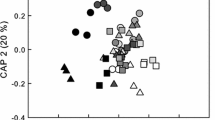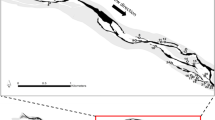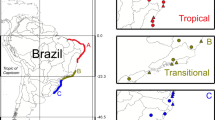Abstract
The intermediate disturbance hypothesis (IDH) predicts a hump-shaped relationship between regional diversity and the disturbance rate. We tested the IDH for the megabenthos inhabiting the Antarctic sea floor, which is disturbed by iceberg scouring. We used models based on the empirical knowledge of succession to calculate the IDH curve for this system and to extrapolate the presently observable range of the IDH curve to higher and lower disturbance rates. Although the hump-shaped relationship has been found for a purely theoretical (extremely large) disturbance range, within the feasible disturbance range (assumed as realistic in the Antarctic region under climate change), the regional diversity of successional stages due to iceberg scouring strongly decreases with lower disturbance rates but levels off only slowly with higher disturbance rates. The reason is the unevenness in the lifetimes of the successional stages, in that early stages are short-lived whereas late stages are long-lived. With such unevenness, increasing disturbances support the early stages without jeopardizing the later ones. Additionally, we converted this regional diversity of stages to the regional diversity of taxa using a transformation formula based on empirical knowledge of the number and mean abundance of taxa in the particular stages. Our results suggest that a decrease in iceberg scouring due to climate change would be more detrimental to the diversity of the Antarctic megabenthos than an increase.





Similar content being viewed by others
References
Arnaud, PM. 1977. Adaptations within the Antarctic marine benthic ecosystem. In: Lano GA, Ed. Adaptations within Antarctic ecosystems. Proceedings of the 3rd Scientific Committee on Antarctic Research Symposium on Antarctic Biology. Houston: Gulf Publishing Co., p. 135–57
Arntz WE, Gallardo VA. 1994. Antarctic benthos: present position and future propects. In: Hempel G, editor. Antarctic science. Berlin: Springer-Verlag. p 243–77
Arntz WE, Gutt J, Klages M. 1997. Antarctic marine biodiversity: an overview. In: Battaglia B, Valencia J, Walton DWH, editors. Antarctic communities: species, structure and survival. Cambridge (UK): Cambridge University Press. p 3–14
Barnes DKA 1999. The influence of ice on polar nearshore benthos. J Mar Biol Associ UK 79:401–7
Bradbury RH 1995. Intermediate disturbance hypothesis in phytoplankton ecology [review]. Aquat Bot 51:341–2.
Brey T, Gerdes D, Gutt J, Mackensen A, Starmans A. 1999. Growth and age of the Antarctic bryozoan Cellaria incula on the Weddell Sea shelf. Antarct Sci 11:408–14
Brown KM, Fraser KPP, Barnes DKA, Peck LS. 2004. Links between the structure of an Antarctic shallow-water community and ice-scour frequency. Oecologia 141:121–9
Buckling A, Kassen R, Bell G, Ralney PB. 2000. Disturbance and diversity in experimental microcosms. Nature 408:961–4
Clarke A, Crame JA. 2003. The importance of historical processes in global patterns of diversity. In: Blackburn TM, Gaston KJ editors. Macroecology: concepts and consequences Oxford (UK): Blackwell. p 130–51
Clarke A, Johnston, NM. 2003. Antarctic marine benthic diversity. In: Gibson RN, Atkinson RJA, Oceanography and marine biology: an annual review. Taylor & Francis. p 47–114
Clarke KR, Green RH. 1988. Statistical design and analysis for a “biological effects” study. Mar Ecol Progr Ser 46:213–26
Collins SL, Glenn SM. 1997. Intermediate disturbance and its relationship to within- and between-patch dynamics. N Z J Ecol 21:103–10
Conlan KE, Kvitek RG. 2005. Recolonization of soft-sediment ice scours on an exposed Arctic coast. Mar Ecol Progr Ser 286:21–42
Connell JH 1978. Diversity in tropical rain forests and coral reefs. Science 199:1302–10
Dayton PK 1978. Observations of growth, dispersal and population dynamics of some sponges in McMurdo Sound, Antarctica. Coll Int CNRS. 291:271–82
Dayton PK, Mordida BJ, Bacon F. 1994. Polar marine communities. Am Zool 34:90–9
Dell RK. 1964. Zoogeography of antarctic benthic Mollusca. In: Carrick R, Holdgate M, Prévost J, editors. Biologie Antarctique. Symposium Organisé par le Scientific Committee on Antarctic Research. Paris: Hermann. p 259–62.
Flöder S, Sommer U. 1999. Diversity in planktonic communities: an experimental test of the intermediate disturbance hypothesis. Limnol Oceanogr 44:1114–9
Gaedeke A, Sommer U. 1986. The influence of the frequency of periodic disturbances on the maintenance of phytoplankton diversity. Oecologia 71:25–8
Grassle JF, Sanders HL. 1973. Life histories and the role of disturbance. Deep-Sea Res 20:643–59
Gray JS 2001. Antarctic marine benthic biodiversity in a world-wide latitudinal context. Polar Biol 24:633–41
Grimm V, Frank K, Jeltsch F, Brandl R, Uchmanski J, Wissel C. 1996. Pattern-oriented modeling in population ecology. Sci Total Environ 183:151–66
Gutt J 2000 Some “driving forces” structuring communities of the sublittoral Antarctic macrobenthos. Antarct Sci 12:297–313
Gutt J, Starmans A. 2001. Quantification of iceberg impact and benthic recolonisation patterns in the Weddell Sea (Antarctica). Polar Biol 24:615–9
Gutt J, Piepenburg D. 2003. Scale-dependent impacts of catastrophic disturbances by grounding icebergs on the diversity of Antarctic benthos. Mar Ecol Prog Ser 253:77–83
Gutt J, Starmans A, Dieckmann G. 1996. Impact of iceberg scouring on polar benthic habitats. Mar Ecol Prog Ser 137:311–6
Hubbell SP, Foster RB, O’Brien ST, Harms KE, Condit R, Weschler B, Wright SJ, et al. 1999. Light gap disturbances, recruitment limitation, and tree diversity in neotropical forests. Science 283:554–7
Huston M. 1979. A general hypothesis of species diversity. Am Nat 113:81–101
Huston MA. 1994. Biological diversity: the coexistence of species on changing landscapes. Cambridge (UK): Cambridge University Press
Johst K, Schöps K. 2003. Persistence and conservation of a consumer-resource metapopulation with local overexploitation of resources. Biol Conserv 109:57–65
Johst K, Brandl R, Eber S. 2002. Metapopulation persistence in dynamic landscapes: the role of dispersal distance. Oikos 98:263–70
Kohyama T, Suzuki E, Partomihardjo T, Yamada T. 2001. Dynamic steady state of patch-mosaic tree size structure of a mixed dipterocarp forest regulated by local crowding. Ecol Res 16:85–98
Kowalke J, Tatián M, Sahade R, Arntz W. 2001. Production and respiration of Antarctic ascidians. Polar Biol 24:663–9
Levin SA. 2000. Multiple scales and the maintenance of biodiversity. Ecosystems 3:498–506
Mackey RL, Currie DJ. 2000. A re-examination of the expected effects of disturbance on diversity. Oikos 88:483–93
Magurran AE. 1988. Ecological diversity and its measurement. Cambridge (UK): Cambridge University Press
Maughan BC, Barnes KA. 2000. A ‘minimum stress inflexion’ in relation to environmental and biotic influences on the dynamics of subtidal encrusting communities? Hydrobiologia 440:101–9
Padisák J, Reynolds CS, Sommer U. 1993. Intermediate disturbance hypothesis in phytoplankton ecology. Dordrecht: Kluwer
Picken GB. 1985. Marine habitats—benthos. In: Bonner WN, Walton DWH, editors. Key environments Antarctica. Oxford (UK): Pergamon Press. p 154–72
Pickett STA, Kolasa J, Armesto JJ, Collins SL. 1989. The ecological concept of disturbance and its expression at various hierarchical levels. Oikos 54:129–36
Ratz A. 1995. Long-term spatial patterns created by fire: a model oriented towards boreal forests. Int J Wildl Fire 5:25–34
Roxburgh SH, Shea K, Wilson JB. 2004. The intermediate disturbance hypothesis: patch dynamics and mechanisms of species coexistence. Ecology 359:371–85
Sheil D, Burslem FRP. 2003. Disturbing hypotheses in tropical forests. Trends Ecol Evol 18:18–26
Sommer U. 1995. An experimental test of the intermediate disturbance hypothesis using cultures of marine phytoplankton. Limnol Oceanogr 40:1271–7
Sousa WP. 1979. Disturbance in marine intertidal boulder fields: the nonequilibrium maintenance of species diversity. Ecology 60:1139–225.
Stelter C, Reich M, Grimm V, Wissel C. 1997. Modelling persistence in dynamic landscapes: lesson from a metapopulation of the grasshopper Bryodema tuberculata. J Anim Ecol 66:508–18
Teixido N, Garrabou J, Arntz WE. 2002. Spatial pattern quantification of Antarctic benthic communities using landscape indices. Mar Ecol Prog Ser 242:1–14
Tilman D. 1999. Diversity by default. Science 283:495–6
Turner MG, Romme WH, Gardner RH, O’Neill RV. 1993. A revised concept of landscape equilibrium: disturbance and stability on scaled landscapes. Landsc Ecol 8:213–27
Vandermeer J, Granzow de la Cerda I, Boucher D, Perfecto I, Ruiz J. 2000. Hurricane disturbance and tropical tree species diversity. Science 290:788–91
Whittaker RH, Levin SA. 1977. The role of mosaic phenomena in natural communities. Theoret Pop Biol 12:117–39
Wilson JB. 1994. The ‘intermediate disturbance hypothesis’ of species coexistence is based on patch dynamics. N Z J Ecol 18:176–81
Wootton JT. 2001. Local interactions predict large-scale pattern in empirically derived cellular automata. Nature 413:841–4
Worm B, Lotze H, Hillebrand H, Sommer U. 2002. Consumer versus resource control of species diversity and ecosystem functioning. Nature 417:848–51
Zahl S. 1977. Jackknifing an index of diversity. Ecology 58:907–13
Acknowledgments
We thank the two anonymous reviewers for helpful comments and suggestions.
Author information
Authors and Affiliations
Corresponding author
Appendix
Appendix
Rights and permissions
About this article
Cite this article
Johst, K., Gutt, J., Wissel, C. et al. Diversity and Disturbances in the Antarctic Megabenthos: Feasible versus Theoretical Disturbance Ranges. Ecosystems 9, 1145–1155 (2006). https://doi.org/10.1007/s10021-006-0054-9
Received:
Accepted:
Published:
Issue Date:
DOI: https://doi.org/10.1007/s10021-006-0054-9




